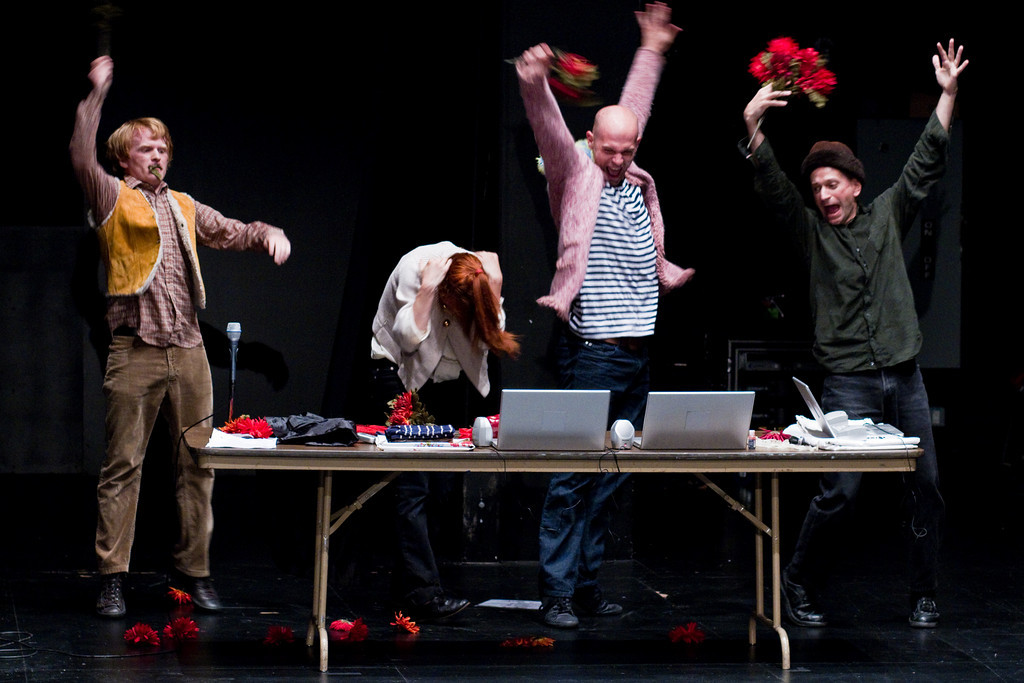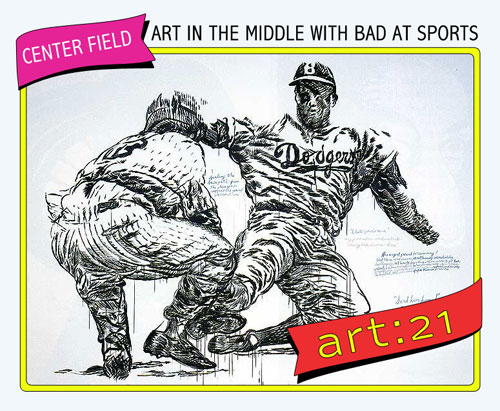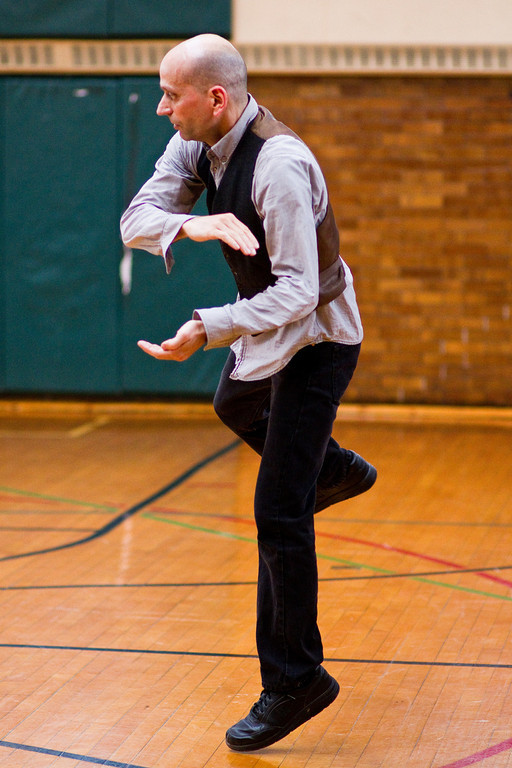“WE MAY AGREE on the premise that each work of art is at least in part perfect, while each critic is at least in part imperfect. We may then look to each work of art not for its faults and shortcomings, but for its moments of exhilaration, in an effort to bring our own imperfections into sympathetic vibration with these moments, and thus effect a creative change in ourselves” (Goulish, “Thoughts on Criticism,” 39 Microlectures, Routledge, 2000).
This June, I saw a performance by Every house has a door, a collaborative group founded by Lin Hixson and Matthew Goulish in 2008 to “create project-specific collaborative performances with invited guests.” Having seen the piece in its intended context I want to ask questions outside its bounds. I appear like a kind of critic—a person asking the artist for something outside the presentation of a complete work. They’re Mending the Great Forest Highway is a dance for three men (Matthew Goulish, Jeff Harms, John Rich), with a DJ (Charissa Tolentino) and a narrator (Hannah Geil-Neufeld). It took place in the second floor gymnasium at Holstein Park in Chicago. Participants enacted a score of movement and sound presenting thematic elements from Hungarian folksongs, the tritone, and Benny Goodman. I wanted to ask about crisis, the framework of the theater, and the vocabulary of gestures—oblique responses to dance. Perhaps by asking them, perhaps through Goulish’s response, you might catch a ghost of the dance, left behind and buzzing in those summer-hot gymnasium walls.
Caroline Picard: How do you conceptualize the context for performance—do you frame it within traditional theater? How does time function within that context?
Matthew Goulish: Yes, theater as the container – less a set of conventions than of structures. Into it we place, let’s say, dance, writing, and music. We keep those elements distinct for clarity. Theater allows their coherent composition in time, the way the parts fit together. What happens first, second, last? What happens where? What echoes, and when? We have a sense of the parts in themselves (dance, music, writing), and another sense of the parts in relation as a cumulative experience (theater).
Can we call any room a theater if it contains theatrical events? What if we set up chairs in the afternoon at one end of a gymnasium that has windows and skylights? A little room noise might help the performance in unexpected ways. If we begin a 60-minute performance on June 18th at 2:00 PM, where will the sun be in the skylight when we end?

Every house has a door , "Let us think of these things always. Let us speak of them never," 2010-2012. Performance. Photo: John W. Sisson, Jr.
CP: I’m interested in the way that your performances take place on a “stage” before a live audience, as well as in video/film; recently, EHHAD created an intersection between stage and film using Ingmar Bergman as a medium. How does your relationship to a performance change, based on the frame in which it is captured?
MG: After having seen two performances of our new work in a room with fifty people, Lin said that Hannah’s first monologue was three lines too long. Which three lines need to be cut? That decision is mine as the writer. Hers was a directorial observation of pure scale – of how long the introduction could last in relation to the other parts, and at what point people stopped listening. Audience amplifies everything. The slightest ripple of reaction running through the room alters everyone’s experience. Theater makes thought visible. A live audience allows this visibility.
In our performance Let us think of these things always. Let us speak of them never, Bergman’s films were a meeting place for the collaborators – myself and Lin and Stephen Fiehn, all from Chicago, and Selma Banich and Mislav Cavajda, from Zagreb, Croatia – in which we were all beginners. The performance became partly about how we encounter one another through mutual regard for an absent third entity. We played film clips on laptop screens averted from the audience. The performers reproduced what the screens showed, in a dance-like game of charades, like interpreters. I think of the messenger describing Oedipus blinding himself. The blinding remains unseen. Some events are too potent to look at directly, like the Medusa-head. The actors are a reflection. They allow difficult events to be examined indirectly or even defeated. Film in this case stood in for the difficult, the historical.
Lin and I have started making short dances for video in response to invitations. We think of these as a “commonplace book” – as commentary or gloss on a found quotation. We match a movement phrase with a line of a poem and juxtapose the two on video. We try to make something that circulates quickly, and perhaps responds to a moment.
I think of all our work now as time-based essay. Can a performance follow an essay form, and retrace a mind’s journey through a question? The stage emphasizes space. The screen emphasizes movement. In either case we want to show a line of thought, through some form of direct address.

Every house has a door,"They're Mending the Great Forest Highway," 2011. Performance. Photo: John W. Sisson, Jr.
CP: There must have been an amazing vocabulary that was regularly exercised over Goat Island’s 22 years. By vocabulary, I mean the ways you would embody and express movement in performance as a group. How has your experience of collaboration shifted with EHHAD?
MG: Each Every house has a door project requires a different set of collaborative strategies, specifically devised for those individuals and the piece. In They’re Mending the Great Forest Highway, for the dance derived from Bartók’s Contrasts, to give one example, I would come into rehearsal with maybe twelve seconds of a “score” of hieroglyphic notations of the music’s rhythms and structures. I’d say, we need a fast gesture, reminiscent of folk dance, that the violin takes two seconds to perform, and plays four times. Then the clarinet twists it into a parody, and stretches it into a four-second phrase. So John might devise possibilities for the violin’s initial statement, and Lin would select one of them. Then Jeff would devise the clarinet’s parodic version. Then we would decide where it all happens on the stage, and submit it to a stopwatch to get the rhythm right. Everyone contributed within extreme limits. It was an adventure, spending two hours of rehearsal making twelve seconds of dance, and trusting that it would all make sense if we stayed close to Bartók’s patterns.
CP: How do you transition your research process into the body? Is the audience located in your awareness during the development process?
Every idea makes its appearance in the process as already embodied. Lin insists that all ideas are performed first and discussed second. Interpretation follows experience rather than dictating it. This resists interpretive closure, and allows a place for feelings, and for the engagement that comes with trying to understand something. Rather than looking at an expectation or projection of meaning, one must look closely and ask what is that? The work lives at that edge.

Every house has a door, "They're Mending the Great Forest Highway," 2011. Performance. Photo: John W. Sisson, Jr.
CP: How do you relate to the idea of crisis in performance? And how about the repetition performance demands? Here too, I feel like I’m asking a question about how you negotiate narrative but everything is interdependent. That’s why I’m thinking about crisis, because it’s so locked into a traditional narrative with a linear arc. From what I’ve seen of your work, you don’t focus on a linear narrative; I feel like there’s an action whereby you pull something interior (or that’s how it reads to me) and expose it to create a different kind of crisis/disruption.
MG: We may think that testimony, that telling the story of a painful event, redeems that event. But trauma scrambles temporal sequence in memory. After experiencing a traumatic event, one might keep retelling the story, trying and failing to get it right, compulsively circling. Linear narrative cannot capture trauma’s rupture, its way of taking you out of time. At least that’s the idea. Musical structures, of telescoping time, of events unfolding out of one another, colliding and interrupting, might capture something of trauma’s force. I say trauma. You said crisis. One difference between the two might be the personal versus the public, different but always intersecting. Let me say it this way. What if we never forget the war? It’s been a long war, and a multiple war. It has made us jittery and sad. How can we escape it, or help end it? How can we look at it indirectly?
The compositional logics and subjects in the three essays collected in my volume from The Institute of Failure rehearse some of this thinking. Each one takes a different approach – humor and discontinuous leaps that make some demented sense; continuous near-hysterical monologue à la Sebald; the overlay of two unfinished essays into one form that tries in its gaps to speak about loss. With those three lectures, I wanted to perform from this notion of crisis, or the structures of trauma, without sacrificing the lightness of the writing. The repeatability of a performance has a peculiar way of lightening its load, making it into a delicate vaudeville poetry. Maybe this is something we can do, a reason to keep working in small and focused forms in the spinning world, or anyway to try.






Pingback: Scores of Performance | The Lantern Daily